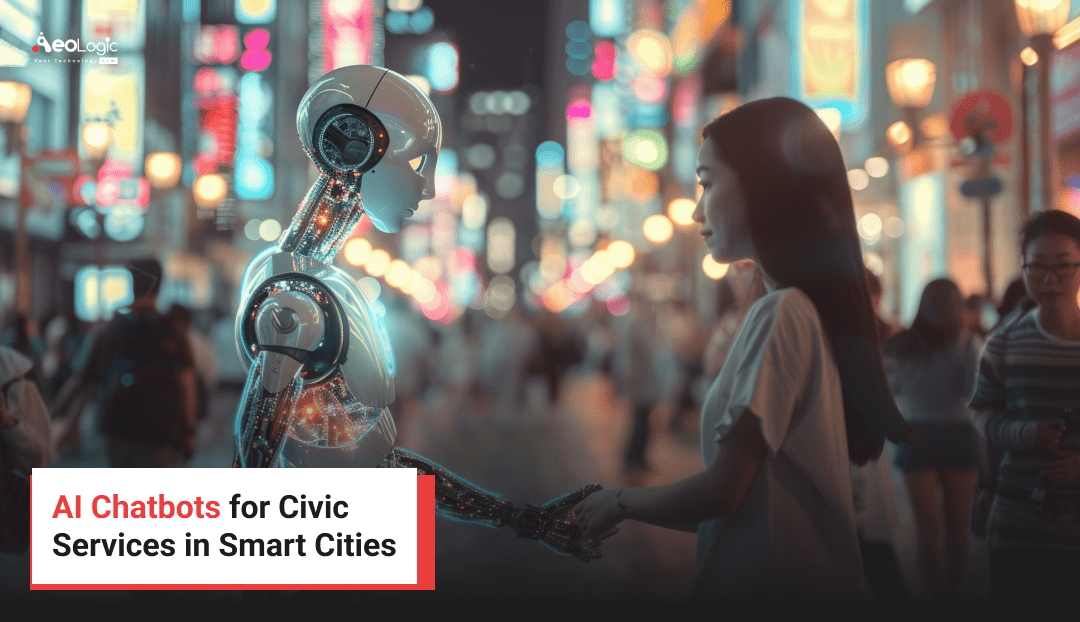Imagine a city where each of its citizens, from the most engaged working professional to the eldest retiree are able to access civic services, instantly anywhere, anytime, any language. By 2030, 68% of the world population will live in urban areas and complex civic systems will be under duress. Citizens cannot accept or tolerate the archaic bureaucratic delays anymore, and an inconceivable queue waits to access the brick and mortar civic services system. Organizations and Agencies have largely shifted to online alternatives but these can still be severely impeded by human wait times and complexities. Enters artificial intelligence Chatbot for Smart City Services the jet fuel to a new paradigm of urban governance, Citizen engagement workflow .
These extraordinary, conversational civic services are not merely an incremental or series of improvements. A new frontier where how cities engage with citizens is fundamentally changed. AI Chatbots Smart City Services such as AI Chatbots engage the public while presenting automated citizen services which are speedier, more inclusive, unlimited, and the future of AI in government portals, foundational to the foundation of many implementations of smart city innovation.
In this blog, we hope to review the various applications, benefits, challenges and a bold leap into the future of Smart Cities with AI chatbots as a citizen-centric best practice for urban engagement. Let’s hit the rubber on the road.
Understanding AI Chatbots and Their Role in Smart Cities
What Are AI Chatbots?
AI chatbots are not your typical automated responders; they are intelligent systems that think, learn, and, above all, communicate with the user like a supercharged city assistant. AI chatbots are based on AI and NLP (natural language processing), capable of processing complex queries, compiling processing and data in real-time, and delivering precise answers 24/7, in multiple languages, and available with the ability to connect with multiple sources of government data. Chatbots can create the neural network of smart city governance, not just in terms of citizen services but in all facets of smart city governance. Whether walking a citizen through a permit application or resolving disputes with utility complaints, AI Chatbots for Smart City Services are designed to handle the chaos of urban demands with the precision of a surgeon.
Civic Services in Smart Cities- The Need for a Revolution
Smart cities are urban ecosystems wired with the internet of things (IoT), AI, and big data designed to optimize everything urban from transportation (traffic flow, autonomous vehicles, loose skateboarders) to utilities (water consumption, usage measurement). However, civics services (e.g., property tax inquiries, license renewals, public safety reports) are slower to convert to smart service alternatives and remain entrenched with massively paper-laden bureaucracies for processing. As urban populations increase, cities face exponential volumes of queries across service sectors.
The 2020s will require cities to address barriers to accessing city services from a variety of potential populations and their respective communities. Civic service resources are limited as conventional call centers and in-person counters (also known as service counters) cannot be expanded or scaled to handle contact volume. AI chatbots are a new disruptive opportunity to transform how cities perform routine legal tasks and connect with communities in automated instant, equitable, fast, and scalable automated citizen services. AI chatbots are considered the Tesla for civic governance.
Key Applications of AI Chatbots in Civic Services
Streamlining Government Portals with AI
Why should individuals have to sift through complicated government sites when artificial intelligence in government portals can help? AI chatbots are like virtual navigators for citizens, and they will make things more efficient like tax filings, business license applications, building permits, etc. Just look at Singapore’s Ask Jamie chatbot. It can take questions from citizens and provide an answer across multiple government departments. The time it saved its users ultimately went from having to wait days a second. Chatbots save time and by automating simple tasks, public sector employees can focus on more complicated matters. AI chatbots can truly make government portals not only efficient but revolutionary.
Enhancing Citizen Engagement
Citizens are the lifeblood of a city, and AI chatbots are the lifeblood of their governance. Communication with the city can range from simple questions about how to vote, to more elaborate levels of engagement where chatbots can provide information on current public events. Chatbots can spur engagement. An example from Dubai’s Rammas chatbot which fielded Arabic and English requests on visas, utilities, and more, to support a vast diversity of a population. The best part is that a chatbot can personalize interactions by adapting future ones from user history such as when a resident is notified about their recycling week or schedule.
This is not just a service, it is a conversation. And not just any conversation it builds trust.
Supporting Public Safety and Emergency Response
When there is a crisis, time is of the essence. AI chatbots allow citizens to report potholes, vandalism, and other incidents in real time, and are often linked with smart city IoT systems so that the problem can be addressed immediately. During emergencies, these problems can be addressed immediately. During emergencies, they can also deliver important messages such as the location of evacuation routes during floods. Toronto’s four pilot projects have demonstrated how chatbots can reduce stress on emergency call centers and to divert non-urgent inquiries away from those services. AI Chatbots for Smart City Services can improve the safety of our cities by implementing citizen connectivity to public safety services and systems.
Managing Utilities and Infrastructure
Damaged streetlights, water leaks, missed waste collection; AI chatbots manage it all seamlessly. When residents report a problem, for instance a streetlight issue, through a city’s website or app, the chatbot files the complaint and keeps a priority list, tracks it, and manages any follow up. Seoul’s infrastructure chatbot, for example, taps into the city systems that can easily link to a service agency to send workers for repairs and keep citizens abreast of the status. So much automation streamlines and reduces overhead, enabling cities to run like a well oiled machine.
Benefits of AI Chatbots for Smart City Civic Services
Driving Operational Efficiency
Artificial intelligence chatbots are the ultimate efficiency tool. Anything that will manage 80% of repeatable questions will save you tons of operating costs and will allow civic staff to focus on more strategic work. Helsinki was able to roll out its chatbot to help lessen call centre overheads, which saved them millions. Chatbots are very much like a reusable Falcon 9 rocket: they are consistently reliable with limited resources. Chatbots will enable more efficiencies in civic services.
Promoting Accessibility and Inclusivity
Smart cities are built on diversity, and AI chatbots ensure that nobody is left behind. They are multilingual and voice enabled to assist both non-native speakers and older people. In Dubai, there is a chatbot that allows a person to switch from Arabic to English with ease. In addition, the voice-enabled options give access to services for individuals with visual impairments.
Moreover, AI Chatbots for Smart City Services provide assistance to and support for every citizen regardless of the time it is, whether it’s 3 a.m. or during the holiday.
Enabling Data-Driven Governance
The chatbot experience is a data point in and of itself, and cities can leverage this data to make better decisions. Some queries and patterns can help pinpoint problems or pain points for citizens; for example, more than just querying complaints about a road condition. The analysis of data could positively influence (and direct) a city’s infrastructure spending. Data informed urban planning is like a Neura link for cities: it connects a citizen’s wants/needs to the policy options that can move those forward. For example, the chatbot may observe patterns that are occurring in transit delays, and the city is then able to address changing the route operationally to improve the delays.
Scalability for Urban Growth
Cities are growing, and as they grow they put more pressure on citizens; more pressure on the public services model and the services that are being offered. AI chatbots scale very well, as they can handle thousands of queries at once. This is especially useful during busy times of the year, such as tax time, where there can be a tremendous volume of returns. Each level of demand does not make them “buckle”. Therefore, putting aside the implications of increased urban dwellers and demand for services, our automated citizen services and the AI-powered chatbots may ultimately be unfazed.
Challenges and Considerations for Implementation
Technical and Ethical Challenges
More power entails more responsibility. Many chatbots will use sensitive data from people in our leagues, and organizations must ensure they use this data responsibly by prioritizing privacy—a major concern. There are regulations and laws, some really robust (like the GDPR), that have even more serious obligations for you in encrypted and secure systems. Not only are privacy concerns prevalent, but municipalities will also need to think about how AI will be trained, so it is not trained against a bias/favourable for a specific demographic with names or addresses. In any of these concerns, I also believe municipalities should think like SpaceX did to keep their rockets safe: Rigor, test and continue to test.
Integration and Financial Hurdles
Connecting chatbots to legacy government systems is similar to retrofitting a Starship for interstellar travel, difficult and very likely expensive. Many cities run on old platforms that are difficult to migrate, creating complications for free-flowing chatbots. Implementing AI also requires an initial investment in infrastructure, and the ongoing costs of maintaining intelligent chatbot systems can strain budgets. Nevertheless, the savings from automation in the long term far exceed these costs, we simply need to be more mindful of the investment.
Encouraging Citizen Adoption
Not all citizens will embrace the evolving emergence of artificial intelligence. Older populations or groups of people who are not accustomed to technology may not institute a chatbot use in their lives. Cities need to create easy-to-use interfaces and run adoption campaigns to ensure that users feel confident and comfortable with a product (Tesla, for example, is the only electric car with a sizable market share adoption by consumers, because they designed a user-friendly product). Pilot projects as well as community workshops are a helpful way to fill this gap and ensure AI Chatbot for Smart City Services is for everyone.
The Future of AI Chatbots in Smart City Civic Services
Integration with Advanced Technologies
The future of AI Chatbots for Smart City Services, now is as bold as colonizing Mars. Integration with the IoT will provide predictive services, e.g. a chatbot that proactively informs citizens when there are water shortages, or utilization of fleet, based on reported sensor data. With natural language processing getting better, the interaction will feel more human than machine and users will be more satisfied. Just imagine a chatbot that did not only learn to respond to your inquiry, but to speak to what you will want to know next! You get the idea.robotic, enhancing user satisfaction. Imagine a chatbot that not only answers your query but anticipates your next need—that’s the goal.
Enabling Participatory Governance
AI chatbots can change cities into democracies of the future. It is easy to visualize how AI chatbots can engage in collecting live feedback on policies or certain urban projects that allows citizens to impact their cities. Imagine a chatbot asking residents to vote on a proposed design for a new park, and integrating all the responses at the same time. This participatory governance method will give cities the chance to evolve with their citizens, not separately.
Global Adoption and Scalability
I foresee AI Chatbots for Smart City Services becoming as prevalent as smartphones, leading governance in cities across the globe. From Singapore to Seoul, the movement is being led by smart cities; however, the revolution is worldwide. Some regions are developing countries that can use inexpensive cloud-based AI platforms to implement chatbots. Overall, this will help equality. By 2035,
Best Practices for Deploying AI Chatbots in Civic Services
Strategic Planning and Prioritization
Cities should treat a chatbot roll-out like the launch of a Starship: calculated and audacious. The first step is to select a few use cases with tremendous possible outcomes (tax questions, utility complaints) and determine how they fit with the objectives of the city. There are a variety of platforms such as Microsoft Bot Framework or Google Dialogflow. They allow for freedom in changing, scalability and flexibility while maintaining the ability to perform.
Ensuring Security and Compliance
Security is paramount in this deployment. Chatbots will have to employ end to end encryption and follow the data protection and privacy policies and laws such as the GDPR. As exemplified by SpaceX with their detailed checklist and prelaunch inspections, cities will need to do regular audits and updates to ensure the systems remain secure. The idea is to partner with reputable AI vendors, which can help mediate compliance and reliability.
Fostering Citizen Trust and Adoption
To get buy-in from citizens, chatbots will have to be as easy to use as a Tesla dashboard. User-friendly interfaces, clear instructions, and pilot projects can help citizens overcome pilot-y fear. Community workshops like those in Dubai can help educate residents on the potential benefits of a chatbot, which would spur even greater uptake of service across demographics.
Conclusion
The time of AI Chatbots being simply another use case has passed; AI Chatbots will be the future of civic services in smart cities. AI in government portal platforms, citizen engagement, and automated services will revolutionize how governments govern.
Virtual assistants or Chat bots will advance the process of governance in government agencies more nimbly, with less bias, and more responsively. While the government will have challenges related to issues of privacy, acceptance of AI Tool adoption, and shared data open access, there is nothing preventing radical innovation from happening before us. Just like Elon Musk sees a future where he can put citizens on Mars, AI Chatbots for Smart City Services are a target to help define the next giant leap for citizen-centric cities. Policymakers, planners, and the technology industry must take concrete and immediate steps to deploy AI as a collaborative partner with disruptors to develop smart cities for every citizen. The future is already here – let’s make positive changes which matter.

Passionate about breaking down complex tech into simple ideas. Covers everything from AI and software development to gadgets and emerging tech trends.






